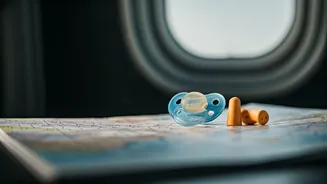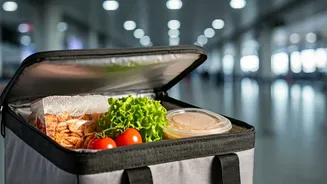Ear Pressure Woes
One of the primary causes of baby crying on flights is changes in air pressure. During ascent and descent, the air pressure in the cabin fluctuates, affecting
the baby's ears. The Eustachian tubes, which connect the middle ear to the back of the throat, are smaller and less developed in infants. This makes it difficult for them to equalize pressure, leading to discomfort and pain. When the pressure changes, the air trapped in the middle ear can cause the eardrum to bulge or retract, creating a sensation of pressure. This can be very distressing for a baby who cannot communicate their discomfort verbally. Parents might observe their babies displaying signs like fussiness, pulling at their ears, or increased crying, especially during takeoff and landing. Offering a pacifier, bottle, or breastfeeding during these times can help, as sucking and swallowing help to open the Eustachian tubes, thereby facilitating pressure equalization.
Sensory Overload Factor
Air travel presents babies with a barrage of new and overwhelming sensory experiences. The enclosed space of the airplane, combined with the continuous noise of the engines, the general hubbub of passengers, and the unfamiliar environment, can easily overstimulate a baby. The constant movement of the plane, the changing lights, and the presence of numerous strangers are all factors that can contribute to a baby's distress. Infants thrive on predictability and routine; a flight disrupts this, throwing them into an unpredictable situation. The close proximity to other passengers also removes the baby's usual comfort of personal space and privacy, which is important for their feeling of safety. To mitigate sensory overload, parents can use strategies like bringing familiar toys or blankets to provide comfort. Creating a quiet zone by dimming the lights, using white noise apps, or earplugs for the baby can also assist in reducing the sensory input. It's beneficial to try and maintain the baby's regular schedule as much as possible, including feeding and nap times, which helps in reassuring them during the journey.
Addressing Discomfort
Besides pressure and sensory issues, babies may cry on flights due to physical discomfort. Babies are unable to adapt to environmental changes as effectively as adults. They may feel the effects of temperature changes or be affected by dry air, which can irritate their skin and nasal passages. The confined space of an airplane also restricts movement and may cause the baby to feel uncomfortable. The air conditioning on airplanes can make the environment chilly, leading to discomfort. Parents can alleviate this by dressing the baby in layers to adjust to the temperature. Regularly moisturizing the baby's skin and using saline drops to keep the nasal passages moist can also help. Carrying the baby and changing positions can also provide comfort and prevent them from being in one position for long periods. Careful preparation with the right clothes, skincare products, and the occasional change of scenery can make a significant difference in the baby's overall well-being.
Prep Before Boarding
Preparation before the flight can greatly impact the likelihood of a smoother journey with your baby. Planning involves several key steps that contribute to the baby's comfort and well-being. Packing a well-stocked diaper bag with essentials like diapers, wipes, changing pads, and a change of clothes is a must. Bring along familiar items such as a favorite toy or blanket to soothe and reassure the baby. Consider packing baby food or formula in the correct quantities and any needed bottles or feeding supplies. Researching the airline's policies on baby-related equipment, such as strollers and car seats, is also beneficial. Taking advantage of early boarding, if offered, is wise, as it gives you extra time to settle in before the rush. Finally, planning your baby's feeding and nap times around the flight schedule can help minimize disruptions. Such preparations may significantly reduce the stress and improve the baby's experience, thus making for a more comfortable travel day.
Onboard Soothing Tactics
Once you're in the air, several strategies can help soothe a crying baby. Sucking is a natural calming behavior for babies, so offering a pacifier, bottle, or breast during ascent and descent can help equalize the pressure in their ears and provide comfort. Rocking or walking with the baby can offer comfort and a sense of security, especially if the plane's environment is too stimulating. White noise, created by a white noise app or the airplane's engines, can also be soothing and help drown out other disruptive noises. Engage your baby with familiar songs, sounds, or toys to distract them from their discomfort and create a sense of normalcy. Communication with nearby passengers, explaining the situation and offering a friendly smile, can foster understanding and cooperation, easing the parents' stress. By being ready with effective soothing techniques, parents can manage their baby's distress and hopefully enjoy a more peaceful flight.











